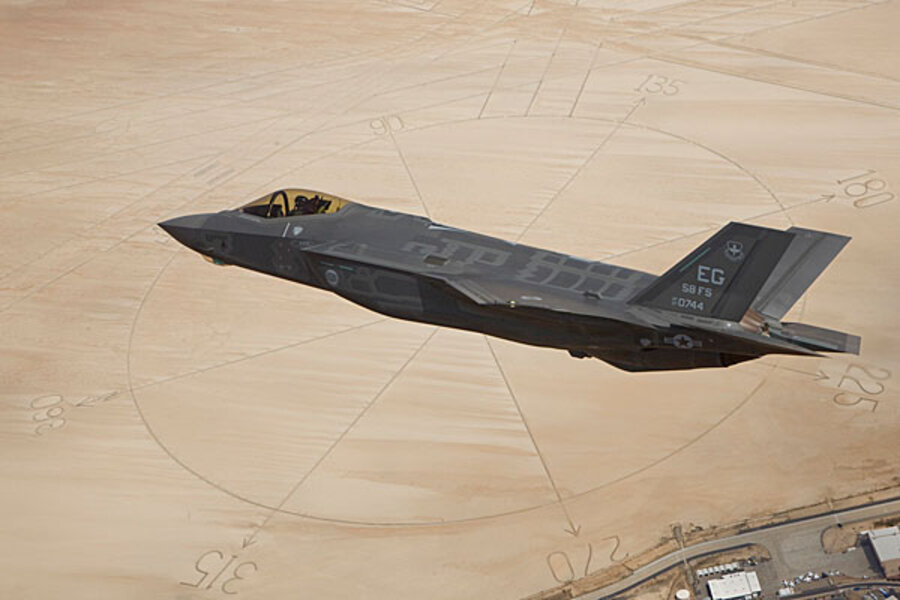F-35 fighter jet: Why orders are up worldwide
Loading...
| Washingtno
Lockheed Martin Corp , nearing completion of its 100th F-35 fighter jet, anticipates dozens of international orders or commitments for the new radar-evading warplane in coming months, according to U.S. government officials and industry executives.
The F-35 program got a boost on Tuesday when the South Korean government rejected a bid by Boeing Co to build 60 F-15SE warplanes, saying it needed a more advanced "fifth-generation" fighter.
It could take up to a year before South Korea completes the next round of its fighter competition, but Lockheed has set its sights on additional orders from Norway, Britain and Turkey before year's end. Experts said the phrasing of South Korea's statement indicated
Boeing had a slim chance of landing a deal.
And Singapore may announce an initial order of one dozen F-35 jets or more at the Singapore air show in February.
Military officials from the United States and eight other countries that helped fund development of the F-35 will meet in Istanbul this week to review progress on the fighter jet that will replace the popular F-16 and a dozen other warplanes now in use around the world, according to a Pentagon spokeswoman.
Moves by Russia and China to develop their own stealthy "fifth-generation" fighter jets have accelerated in recent years, underpinning demand for the F-35. The Pentagon's chief arms buyer this month described the F-35 as the top U.S. conventional weapons program.
Military experts use the term "fifth-generation" to refer to airplanes that have stealthy coatings and other features that make them largely invisible to enemy radars.
Lockheed is building three variants of the F-35 for the U.S. military, and the eight partner countries: Britain, Canada, Australia, Norway, the Netherlands, Italy, Turkey and Denmark. Israel and Japan have also placed orders.
The company will complete building its 100th F-35 fighter plane next week.
The $392 billion F-35 program, the Pentagon's most expensive, has had a number of positive developments over the past year. The F-35 has traveled a long, rocky road that had triggered concerns it could suffer the same "death spiral" that ultimately slashed orders for Lockheed's F-22 fighter from 750 to 187.
Last week, the U.S. Air Force general who runs the F-35 program, said he no longer feared that outcome, given the strong commitment of the U.S. military services and foreign countries.
Air Force Lieutenant General Chris Bogdan said the F-35 was making slow but steady progress on lowering production costs, completing flight tests and resolving technical problems.
FOREIGN ORDERS FIRMING UP
After years of political wrangling, the Netherlands last week became the seventh foreign country to make a firm commitment to buy F-35s, joining Britain, Australia, Italy, Norway, Israel and Japan.
Norway is expected to order six more jets in December, its fourth order for the new warplane, according to one source familiar with the F-35 program.
Britain, which has spent $2 billion to help develop the F-35, will decide next month whether to proceed with the purchase of 14 additional B-model F-35s, which can take off from shorter runways and land like a helicopter.
The UK deal alone would be worth about $1.5 billion, according to a source familiar with the UK program.
The U.S. Marine Corps plans to start using the F-35B version of the new jet, the same one Britain plans to buy, in combat starting in mid-2015, while the U.S. Air Force has moved up plans to start using the conventional takeoff A-model to 2016.
In December or January, Turkey's Defense Industry Executive Committee is expected to approve an initial order of two jets out of the 100 F-35s it plans to buy over time to replace its aging fleet of F-4 Phantoms and early F-16s, according to a second source close to the program.
Japan, which is building a $1 billion final assembly and checkout facility for the F-35, plans to order four more F-35s in the fiscal year starting April 2014 as part of its overall order of 42 F-35 fighter jets to replace its F-4 fighters, according to budget documents.
Japan's Defence Ministry has requested 162.7 billion yen ($1.65 billion) to pay for four F-35s, provide aid to domestic manufacturers building F-35-related production lines, and related training equipment.
Japanese military officials were also considering moves to replace their older F-15 fighter jets, which would likely translate into significant additional F-35 orders in coming years, according to one source who was not authorized to speak publicly.
Meanwhile, Singapore was moving closer to formalizing plans for an initial order of F-35s, according to U.S. and industry officials, who say an announcement about a dozen or more jets could come at the Singapore air show in February.
Belgium, one of the original NATO partners to buy the F-16, is also considering buying the F-35, Reuters reported last week. although no decision was expected until late 2014 or early 2015.







